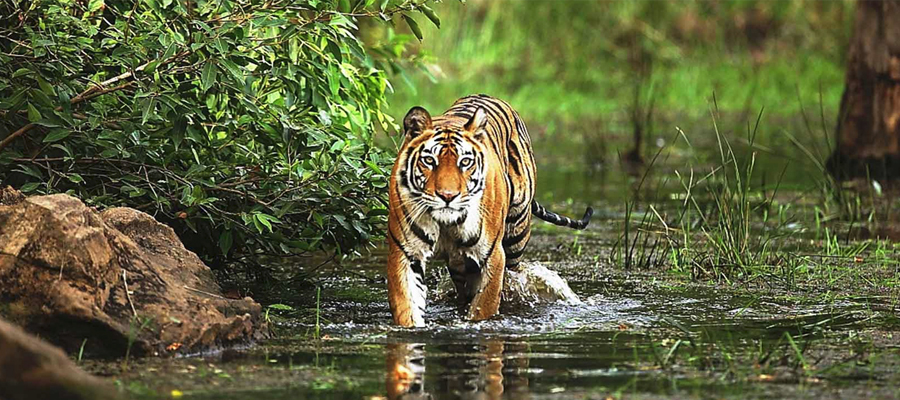
Overview
Bandhavgarh National Tiger Reserve in Madhya Pradesh features among the top-notch tiger reserves of India as it is a relatively compact forest area at just 428 sq km with the highest population of tigers than anywhere else in India. It is popularly vouched that nine of ten tourists would certainly spot a tiger during a visit to the coveted tiger reserve, especially in the Tala range that is abundant in water holes.
Introducing Bandhavgarh
Erstwhile a royal hunting ground for the Maharajas of Rewa to put down numerous tigers in the name of royal past time, the forest of Bandhavgarh was thankfully declared a national park post-independence in 1968. The wildlife sanctuary is named after the weathering Bandhavgarh Fort inside and often touted to be the inspiration behind the Jungle Book by Rudyard Kipling.
Today the Bandhavgarh forest cradles a rich variety of wildlife of India, besides the royal Bengal tigers in impressive numbers. It is home to several other carnivores including leopards, sloth bears, striped hyenas, jackals, jungle cats and wild boars. Tourists can also hope to spot Indian bison, deer, chausingha, nilgais, chinkara, langur and over 250 species of birds in the forest area.
Not to mention, Bandhavgarh Tiger Reserve India also welcomes tourists to several points of interest within the park like the Climber's Point at 13,005 feet for an exceptional panoramic view of the park. Bandhavgarh fort atop the 811 meters high Bandhavgarh hill is at least 2000 years old and a trek to the top is both refreshing and exciting. Over 30 ancient caves on Bandhavgarh sandstone hills are also quite intriguing to visit as some of these date back to as old as the 10th century and carry inscriptions in ancient Brahmi script. In addition, Baghel Museum is also a decent draw that extends one the opportunity to glance through the various regal belongings of the Kings of Rewa, especially their hunting and military paraphernalia. Besides, Andheri Jhiria, Ketkiha, Bhitari Bah and Rajbahera are worth exploring when inside the national park.
Heritage Places / Sightseeing in Bandhavgarh
- Bandhavgarh wildlife tours to Tala range
The most sought after as the prospects of spotting a royal Bengal tiger are the ripest in this range. Options are available to book a jeep safari that usually entails two trips to the park on a 4WD gypsy – once at sunrise and another in the late afternoon. Elephant safari can also be booked for the whole day. Bird watchers tend to opt for jeep safaris to explore the Bandhavgarh jungles to spot from over 200 bird species that reside in the park, including the white-bellied drongos, parakeets, eagles, owls, green pigeons, gray Malabar Hornbills, browed fantails, green bee eaters, gold fronted leaf birds etc. Entry to the Bandhavgarh fort opens at a small slow-paced Tala village in Umaria district, situated 32 km away from the Umaria railway station.
- Climber's Point
Abundant in a host of plant species, Climber's Point is a haven for botany enthusiasts. From the gorgeous Sal trees to Bauhinia Vahlii – the greenery surrounding the point is ideal for a peaceful and relaxed time amidst nature and spectacular panoramic views of the Bandhavgarh forest.
- Bandhavgarh Fort
Perched atop one of the tallest Bandhavgarh hills in the center of the national park, Bandhavgarh Fort is located on a plateau of 4 sq km at the height of 811 meters above sea level. The fort is believed to be over 2000 years old with historical references to the fort found in Hindu epic Ramayana. The fort is surrounded by 31 other smaller hills and hillocks, punctuated by sloping valleys, everything more or less enveloped in forest cover. Presently in ruins with forest cover meshing up with the structure at quite a few places, the fort is easily visible from any given point in the national park. A curious survey of the fort would lead a tourist to several statues carved out of rocks personifying various characters from Hindu literature, including the Shesh Shaiyya depicting Lord Vishnu in reclining pose.
The fort is still owned by the King of Rewa and special permission is required from the authority to visit it.
- Bandhavgarh Caves
The hill holding the fort and the surrounding sandstone hills house around 39 natural and manmade caves. These caves carry evidence of belonging to the pre-historic times owing to their rather plain appearance as well as inscriptions in hoary Brahmi script as well as figures of tigers, elephants, wildboar etc. found etched on the walls of the caves. Possibly military strongholds of Bahela Rajputs once upon a time and even inhabited by sages during their spiritual pursuits at some point of time, the caves are now home to only bats and many a times tigresses with cubs, as male tigers are reluctant to venture into the territory. Badi Gufa or the big cave is the biggest cave of all, man-made and dating back to the 10th Century.
How to reach Bandhavgarh
By AirThere are no airports close by and the nearest airport to Bandhavgarh is Jabalpur about 190 km followe by Khajuraho about 210 km away. It takes around five hours by road to reach Bandhavgarh tiger reserve from either airport.
By RailRailway Station at Umaria district is the closest to Bandhavgarh about 30 km away. The railway station is well connected to all the major cities in India including Delhi. Buses and taxis in plenty operate from Umaria to reach Bandhavgarh.
By RoadIt is easy to reach Bandhavgarh by road as the highways leading to the tiger reserve are well in place and suitably marked as well once you reach Umaria.
The best time to visit Bandhavgarh National Park
While summer months from March to mid-June offer riper opportunities to sight a tiger around one of the waterholes, winter months from October to February feel quite pleasant for the tourist instead. The best time to visit the Bandhavgarh Tiger Reserve is as such more of a subjective decision than otherwise. One season, however, that anyone must avoid is the monsoon season that more or less begins in mid-June. The national park anyways remains closed from July to September end during monsoon season.

